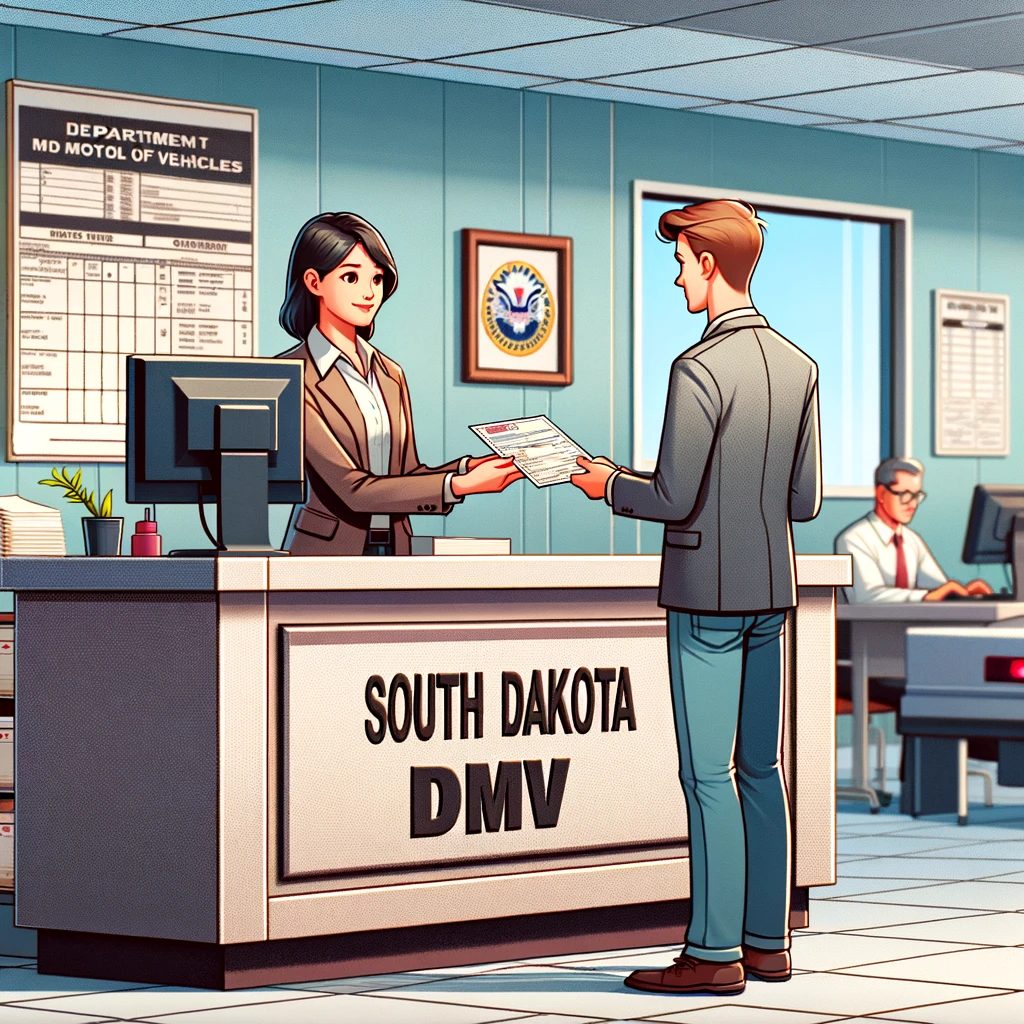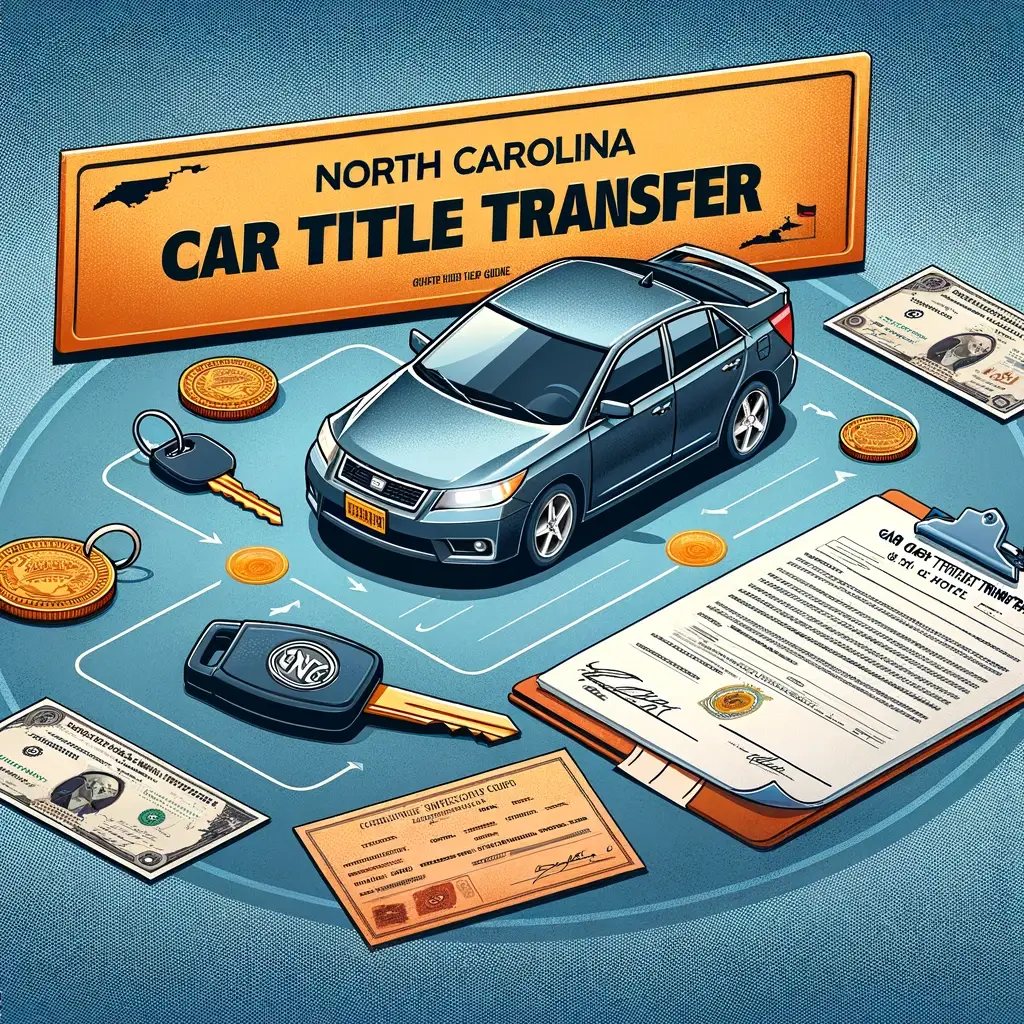Welcome to our comprehensive guide on navigating the vehicle title transfer process in South Dakota. In this detailed and informative article, we will walk you through every aspect of this essential process, ensuring that you have all the information you need to smoothly transfer vehicle ownership while adhering to South Dakota’s state laws and regulations.
Understanding the Significance of Vehicle Title Transfer
Legal Importance and Peace of Mind
Vehicle title transfer is not just a formality; it holds significant legal importance. When a vehicle changes ownership, the title transfer ensures that the new owner is legally recognized. This process is crucial for protecting the interests of both parties involved and ensuring compliance with South Dakota’s state laws. It also brings peace of mind to both the buyer and the seller, as they can be confident that the transaction is conducted within the bounds of the law.
Section 1: Demystifying Vehicle Title Transfer
What is a Vehicle Title Transfer?
A vehicle title transfer is the legal process of transferring ownership of a vehicle from one party to another. It involves the official change of the title certificate, which signifies the new owner of the vehicle.
Importance of Title Transfer
Title transfer is essential for several reasons. Firstly, it legally documents the change of ownership, protecting both the buyer and the seller from potential disputes. Secondly, it ensures that the new owner is aware of any existing liens or encumbrances on the vehicle. Lastly, it is required by South Dakota state law, and failing to complete the transfer can result in legal consequences.
The importance of a vehicle title transfer cannot be overstated for several reasons:
- Legal Documentation: Firstly, it serves as legal documentation of the change in ownership. This documentation is crucial as it provides an official record of the transaction, ensuring that both the buyer and the seller have evidence of the transfer. In case of any disputes or legal issues in the future, this document acts as proof of the rightful owner.
- Protection from Disputes: Secondly, a title transfer protects both the buyer and the seller from potential disputes. It clearly establishes who is now responsible for the vehicle, its condition, and any associated liabilities. Without a proper title transfer, disagreements can arise over ownership, leading to legal conflicts.
- Lien and Encumbrance Awareness: Additionally, the title transfer process ensures that the new owner is made aware of any existing liens or encumbrances on the vehicle. Liens are legal claims against the vehicle, typically due to unpaid debts. By knowing about these claims, the new owner can address them appropriately and avoid unexpected financial obligations./0258\’;[p
- Legal Requirement: Finally, in South Dakota, title transfer is not just a recommended practice; it is a legal requirement. State law mandates that vehicle ownership changes must be officially documented through title transfer. Failing to complete this transfer in accordance with the law can result in legal consequences, including fines and penalties.
In summary, a vehicle title transfer is a vital legal process that safeguards the interests of both the buyer and the seller, ensures the accurate documentation of ownership changes, and helps maintain compliance with state laws. It is a fundamental step in the vehicle buying and selling process that should not be overlooked.
Section 2: Essential Preparations for Title Transfer
Gathering Key Documents
Before initiating the title transfer process, it is essential to gather the necessary documents. These include:
- Certificate of Title: This document is of utmost importance as it serves as the primary proof of ownership for the vehicle. Both the buyer and seller must have this certificate.
- Bill of Sale: The bill of sale is a legal document that records the sale of the vehicle. It includes details such as the purchase price, the names of the buyer and seller, and the vehicle’s description. It’s a crucial piece of evidence in the transfer process.
- Valid Identification: You will need valid identification to confirm your identity during the title transfer. This typically includes a driver’s license or other government-issued identification.
- Proof of Insurance: Proof of insurance is required to ensure that the vehicle being transferred is adequately insured. It’s a vital component of the process.
The Certificate of Title, in particular, plays a central role as it is the primary document used for transferring ownership. Without it, the title transfer cannot proceed.
Form 1001: The Gateway to Transfer
Form 1001 is a vital document in the title transfer process. It serves as the official application for title transfer in South Dakota. To initiate the transfer process, you must obtain this form and ensure its accurate completion. This form essentially acts as the gateway to the entire title transfer process, and it is crucial to follow the instructions and provide accurate information when filling it out.
Section 3: The Application Process Unraveled
Filling Out Form 1001: A Step-by-Step Guide
Filling out Form 1001 is a critical step in the vehicle title transfer process, and while it may initially appear complex, our step-by-step guide will simplify the process for you. Here’s a detailed breakdown of how to fill out Form 1001 accurately:
- Obtain Form 1001: The first step is to obtain a copy of Form 1001, which serves as the official application for title transfer in South Dakota. You can typically find this form online on the South Dakota Department of Revenue’s website or at your local county treasurer’s office.
- Complete Personal Information: Begin by providing your personal information, including your full name, address, and contact details. Ensure that this information is accurate and matches the details on your identification documents.
- Vehicle Information: Fill in all the pertinent details about the vehicle being transferred. This includes the vehicle’s make, model, year, and Vehicle Identification Number (VIN). Be meticulous when recording this information, as errors can lead to delays or complications.
- Seller’s Information: If you are the seller, provide your information here. This includes your name, address, and contact details. If you are the buyer, you’ll need to provide the seller’s information as well.
- Buyer’s Information: If you are the buyer, provide your information in this section, including your full name, address, and contact details.
- Lienholder Information: If there is an existing lien on the vehicle, you must include the lienholder’s information, including their name and address.
- Notarization: Some sections of Form 1001 may require notarization, which means you’ll need to have your signature witnessed by a notary public. Ensure that you sign in the presence of the notary and provide any required identification.
- Review and Verification: Before submitting the form, carefully review all the information you’ve provided to ensure its accuracy. Any mistakes or omissions can lead to delays in the transfer process.
- Submit the Form: Once the form is complete and verified, you can submit it. You may need to pay a fee, which varies depending on the circumstances of the transfer.
Understanding Fees and Payment Methods
To successfully navigate the title transfer process, it’s essential to have a clear understanding of the fees involved and the available payment methods. Here’s an in-depth explanation:
- Fee Structure: Title transfer fees can vary based on factors such as the vehicle’s value, the type of transfer (e.g., sale, gift, inheritance), and whether there are any outstanding taxes or liens. It’s crucial to consult the South Dakota Department of Revenue’s fee schedule or website to determine the exact fee applicable to your situation.
- Payment Options: South Dakota typically accepts various payment methods, including cash, checks, money orders, and electronic payment options. The accepted payment methods may vary depending on where you submit the application. Be sure to check with the specific office or agency where you plan to submit your title transfer application to confirm their accepted payment methods.
- Additional Costs: In addition to the title transfer fee, there may be other associated costs, such as sales tax, registration fees, and any applicable penalties or late fees. These costs can also vary, so it’s essential to factor them into your budget.
- Budgeting: To budget effectively for the title transfer, calculate the total costs involved, including the title transfer fee and any additional fees or taxes. This will help you plan accordingly and ensure that you have the necessary funds to complete the process.
Application Submission: Mail vs. In-Person
When it comes to submitting your title transfer application, you have two main options: mail or in-person submission. Each method has its advantages and considerations:
Mail Submission:
- Pros:
- Convenient for those who prefer not to visit a physical office.
- Can be done from the comfort of your home.
- Suitable for individuals with busy schedules.
- Cons:
- Longer processing times as it involves mailing documents.
- Limited ability to address immediate questions or issues.
In-Person Submission:
- Pros:
- Faster processing times, as you can submit documents directly.
- Allows for immediate clarification of any questions or issues.
- Ideal for those who prefer face-to-face interactions.
- Cons:
- Requires a visit to a physical office, which may not be convenient for everyone.
- May involve waiting in line during peak times.
The choice between mail and in-person submission ultimately depends on your preferences, timeline, and convenience. Consider your own circumstances and choose the method that best suits your needs when submitting your title transfer application.
Section 4: After Submission – What’s Next?
Post-Submission Tracking and Receiving Your Title
Once you’ve submitted your title transfer application, it’s essential to keep track of its status to ensure a smooth process. Here’s a guide on what to do next:
- Confirmation of Submission: After you’ve submitted your title transfer application, you should receive a confirmation of submission. This confirmation may include a reference number or receipt that you can use for tracking purposes.
- Processing Time: The processing time for title transfer applications can vary. It’s advisable to check with the relevant South Dakota state agency or office to determine the expected processing time for your specific situation. Keep in mind that processing times may be longer during peak seasons.
- Online Tracking: Some state agencies offer online tracking services that allow you to monitor the status of your application. Visit the official South Dakota Department of Revenue website and look for the section dedicated to tracking title transfer applications. You may need to input your reference number or other identifying information to access the status.
- Contacting the Office: If online tracking is not available or if you have specific questions about your application, don’t hesitate to contact the office or agency where you submitted your application. They can provide you with updates on the progress of your title transfer and address any inquiries you may have.
- Receiving Your Title Certificate: Once your title transfer application is approved and processed, you will receive your new title certificate. This certificate will reflect the updated ownership information. It’s essential to carefully review the certificate to ensure that all details are accurate. Any errors should be reported and corrected promptly.
- Safekeeping Your Title Certificate: Your title certificate is a vital legal document, and you should keep it in a safe and secure place. It’s recommended to store it in a location where you can easily access it when needed, such as a secure folder or a safe. Losing the title certificate can lead to complications and additional paperwork.
- Notification of Completion: In some cases, you may receive official notification of the completion of the title transfer process. This notification serves as confirmation that the transfer is finalized, and you are now the legal owner of the vehicle.
- Further Inquiries: If you have any further questions or concerns about your title transfer, do not hesitate to reach out to the relevant state agency or office. They can provide guidance and assistance to ensure that the process is completed successfully.
Remember that the title transfer process may involve additional steps or considerations depending on your specific circumstances, such as out-of-state transfers or handling title transfers for leased vehicles. It’s crucial to stay informed and follow up as needed to ensure a smooth and successful title transfer.
Section 5: Special Circumstances and Considerations
Timely Transfers and License Plate Protocols
Understanding the 45-day Window for Title Transfers:
In South Dakota, there is a crucial timeframe to be aware of when it comes to title transfers – the 45-day window. Here’s an in-depth explanation:
- 45-Day Deadline: When you buy or acquire a vehicle, whether through purchase, gift, or inheritance, you have 45 days from the date of the transaction to complete the title transfer. This means that you must initiate the transfer process within this timeframe to comply with South Dakota state law.
- Importance of Timely Transfers: Timely transfers are essential for several reasons. Firstly, it ensures that the new owner’s name is officially recorded on the title certificate, which is crucial for legal recognition. Secondly, it helps prevent any potential legal issues or disputes that may arise if the transfer is not completed promptly.
- Penalties for Late Transfers: Failing to complete the title transfer within the 45-day window can result in penalties and fines. These penalties may vary depending on the specific circumstances and the length of the delay. To avoid unnecessary costs and legal complications, it’s imperative to adhere to this deadline.
Proper Handling of License Plates During the Transfer Process:
When dealing with title transfers, it’s essential to understand the proper handling of license plates:
- Removing License Plates: If you are the seller, it’s typically your responsibility to remove the license plates from the vehicle at the time of sale. These plates belong to you, not the vehicle, and should be retained. Failure to remove your license plates can lead to potential liabilities or misuse of the plates.
- Temporary Permits: In some cases, you may need to obtain a temporary permit to legally drive the vehicle after the sale. Temporary permits are typically issued to buyers to allow them to transport the vehicle to their residence or a designated location. Be sure to inquire about the requirements for temporary permits when completing the title transfer.
Out-of-State Purchases and Temporary Permits
Dealing with out-of-state vehicles requires specific considerations, and temporary permits may come into play:
- Out-of-State Vehicles: If you are purchasing a vehicle that is registered in another state, you will need to navigate the process of transferring the title from the previous state to South Dakota. This process can be more complex than an in-state transfer and may involve additional documentation and fees.
- Temporary Permits: In some cases, you may require a temporary permit to drive the out-of-state vehicle legally within South Dakota before completing the title transfer. Temporary permits are typically issued by the South Dakota Department of Revenue and provide a legal grace period for the transfer process.
- Documentation and Requirements: When dealing with out-of-state vehicles, it’s crucial to research and understand the specific documentation and requirements for the title transfer. This may include obtaining a vehicle history report, verifying the vehicle’s VIN, and complying with any emissions or safety inspections.
- Compliance with South Dakota Laws: Ensure that the out-of-state vehicle meets South Dakota’s safety and emissions standards. This may require modifications or adjustments to the vehicle to align with state regulations.
Navigating the title transfer process for out-of-state vehicles can be intricate, and it’s advisable to seek guidance from the South Dakota Department of Revenue or a qualified professional to ensure a smooth and compliant transfer.
Section 6: Legalities and Penalties in SD Title Transfer
South Dakota’s Legal Framework for Title Transfer
Understanding the legal framework of South Dakota is vital when it comes to title transfers. Here’s a comprehensive exploration of state laws pertaining to title transfers:
- State Jurisdiction: Title transfers of vehicles in South Dakota fall under the jurisdiction of the South Dakota Department of Revenue’s Motor Vehicle Division. This agency is responsible for overseeing and regulating the title transfer process in the state.
- Title Transfer Requirements: South Dakota law mandates that all vehicle transfers must be documented through a proper title transfer process. This means that when a vehicle changes ownership, whether through sale, gift, inheritance, or any other means, the new owner’s name must be officially recorded on the vehicle’s title certificate.
- 45-Day Window: As previously mentioned, South Dakota law imposes a 45-day deadline for completing title transfers after acquiring a vehicle. Failing to adhere to this timeframe can result in penalties and fines.
- Proof of Ownership: The Certificate of Title is the primary document used to establish proof of ownership in South Dakota. It is crucial to have a valid and accurate certificate during the transfer process.
Consequences of Late or Incorrect Transfers
Understanding the penalties and repercussions of late or incorrect title transfers is essential to avoid legal issues:
- Penalties: South Dakota imposes penalties for late title transfers. The specific penalties may vary depending on the length of the delay and the circumstances of the transfer. These penalties can include fines, which can escalate the longer the transfer is delayed.
- Legal Liabilities: Failing to complete a timely and accurate title transfer can result in legal liabilities. If an accident or other legal issue involving the vehicle occurs, the previous owner may still be legally considered the owner on record, leading to potential legal disputes and financial responsibilities.
- Insurance Complications: Incorrectly transferred titles can also lead to complications with insurance coverage. If the insurance policy is not updated to reflect the new owner, coverage may be invalid or inadequate, leaving both parties exposed to risks.
- Difficulty Selling or Registering the Vehicle: Without a properly transferred title, it can be challenging to sell or register the vehicle in the new owner’s name. This can hinder the ability to use or sell the vehicle legally.
In summary, South Dakota has a well-defined legal framework for title transfers, and it is essential to comply with state laws to avoid penalties, legal complications, and potential liabilities. Timely and accurate title transfers are not only a legal requirement but also a means of protecting the interests of both buyers and sellers in vehicle transactions.
Section 7: Overcoming Common Transfer Obstacles
Tackling Delays and Application Rejections
When dealing with title transfers, it’s essential to be aware of common issues that can lead to delays and application rejections. Here are strategies to overcome these obstacles and ensure a smooth transfer process:
- Documentation Accuracy: One of the most frequent causes of delays and rejections is inaccurate or incomplete documentation. To avoid this, carefully review all forms and documents before submission. Double-check that all information is correct, signatures are in the right places, and any notarization requirements are met.
- Notarization: Ensure that any sections of the title transfer application requiring notarization are completed correctly. This includes having your signature witnessed by a notary public if necessary. Failure to do so can lead to rejections.
- Timely Submission: Adhere to the 45-day window for title transfers. Initiating the process promptly can prevent delays and penalties associated with late transfers.
- Communication: If you encounter challenges or have questions during the process, do not hesitate to reach out to the relevant state agency or office. They can provide guidance and address any issues that may arise.
- Professional Assistance: If you find the title transfer process complex or have concerns about potential obstacles, consider seeking professional assistance from experts who specialize in vehicle title transfers. They can navigate the process efficiently and help you avoid common pitfalls.
Lost or Damaged Titles: A Recovery Guide
Losing or damaging a title certificate can be a setback, but it’s not insurmountable. Here’s a step-by-step guide on how to recover lost or damaged titles:
- Notify Authorities: If your title certificate is lost or damaged, notify the South Dakota Department of Revenue’s Motor Vehicle Division immediately. Reporting the loss or damage promptly is essential to prevent potential misuse of the title.
- Complete Affidavit: In some cases, you may need to complete an affidavit of lost or damaged title. This document serves as an official declaration of the circumstances surrounding the loss or damage. Ensure that the affidavit is filled out accurately.
- Provide Proof of Ownership: You may be required to provide proof of ownership, such as vehicle registration documents or a copy of the previous title, to establish your rightful ownership of the vehicle.
- Pay Fees: There may be fees associated with obtaining a duplicate title certificate. Be prepared to pay these fees as required by the South Dakota Department of Revenue.
- Wait for Processing: After submitting the necessary documentation and fees, you’ll need to wait for the processing of your request. Processing times may vary, so it’s advisable to inquire about the expected timeline.
- Receive Duplicate Title: Once your request is processed and approved, you will receive a duplicate title certificate. Carefully review the certificate to ensure that all details are accurate.
- Safeguard the Duplicate: Treat the duplicate title certificate with the same care as the original. Store it securely to prevent future loss or damage.
In summary, overcoming common transfer obstacles involves attention to detail, timely action, and effective communication. When facing issues like delays or lost titles, following the appropriate steps and seeking professional guidance when needed can help you navigate the title transfer process successfully.
Section 8: Resources and Assistance
Comprehensive Information Sources
Navigating the title transfer process in South Dakota becomes more accessible with access to comprehensive information sources. Here, we provide links to official resources and offices where you can find additional information regarding title transfers in the state:
- South Dakota Department of Revenue – Motor Vehicle Division: The official website of the South Dakota Department of Revenue’s Motor Vehicle Division is a valuable resource. It offers detailed information on title transfers, including forms, requirements, and contact information for local offices. You can access this resource at SD Department of Revenue – Motor Vehicle Division.
- Online Forms and Publications: The South Dakota Department of Revenue’s website provides access to a range of online forms and publications related to vehicle title transfers. These documents can be instrumental in understanding the process and ensuring you have the necessary paperwork. Visit SD Department of Revenue Forms.
- Local County Treasurer’s Offices: Each county in South Dakota has a County Treasurer’s Office that handles various motor vehicle services, including title transfers. These local offices can provide specific guidance on title transfers in your area. You can find contact information for your local office on the South Dakota Department of Revenue’s website.
Helplines and FAQs
When you have questions or need expert assistance during the title transfer process, help is just a phone call away. Additionally, we’ve compiled answers to frequently asked questions to address your concerns effectively:
1. How long does the title transfer take?
- The time required for a title transfer can vary depending on factors such as the complexity of the transfer and the processing times at the relevant office. To get a more precise estimate, it’s advisable to check with your local County Treasurer’s Office or the South Dakota Department of Revenue.
2. Can title transfer be done online in SD?
- Some title transfer services may be available online, but the availability and eligibility criteria can vary. It’s best to consult the South Dakota Department of Revenue’s official website or contact their office for information on online title transfer options.
3. What are the associated fees?
- Title transfer fees can vary depending on factors such as the type of vehicle, its value, and any applicable taxes. You can find detailed fee information on the South Dakota Department of Revenue’s website or by contacting your local County Treasurer’s Office.
4. Steps to take if the new certificate of title is lost.
- If your new certificate of title is lost or damaged, refer to our earlier section on “Lost or Damaged Titles: A Recovery Guide” for step-by-step instructions on how to recover it.
5. Title transfer for gifted or inherited vehicles.
- The process for title transfer of gifted or inherited vehicles follows similar guidelines to standard transfers. Ensure that you have the necessary documentation to prove the gift or inheritance, and follow the steps outlined in the title transfer process.
6. Exceptions to the 45-day title transfer rule.
- While the 45-day window is generally applicable, there may be exceptions or circumstances that require additional time. It’s advisable to contact the South Dakota Department of Revenue or your local County Treasurer’s Office to discuss any potential exceptions and seek guidance.
7. Required insurance information.
- South Dakota may have specific insurance requirements for vehicle ownership and title transfers. Check with your insurance provider to ensure you meet the necessary coverage and documentation requirements.
In conclusion, these resources and assistance options provide valuable support for individuals navigating the title transfer process in South Dakota. Whether you need official forms and information or have questions that require expert guidance, these tools are designed to help you successfully complete your title transfer with confidence.
FAQ Section
Conclusion
Successfully Navigating Vehicle Title Transfer in South Dakota is paramount. By following the comprehensive guidelines outlined in this article, you can ensure compliance with state laws and enjoy a smooth transition of vehicle ownership. Don’t let the title transfer process overwhelm you; we’re here to guide you every step of the way.
Read More :
HOW TO RENEW YOUR CAR REGISTRATION IN 2023









